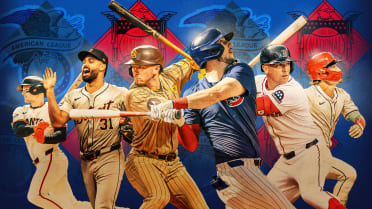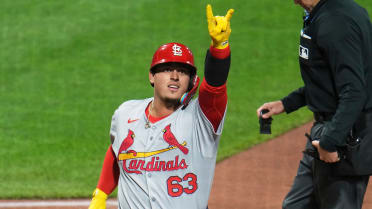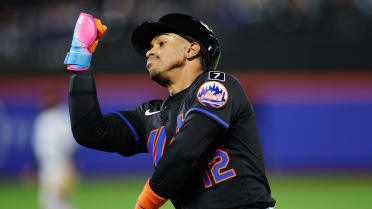One of the lasting memories from this postseason will be the torrid hitting of Randy Arozarena.
But how exactly Arozarena’s amazing run will be remembered is a more interesting question. Will it be viewed as a star’s coming-out party? A total fluke? Or just a historic, well-timed hot streak from a solid big leaguer?
While Arozarena seemingly came out of nowhere, with just 99 regular-season MLB plate appearances prior to this postseason, there had been indications of his significant potential.
Over the past two years, the 25-year-old crushed the ball in Double-A (.938 OPS in 28 games), Triple-A (1.028 OPS in 64 games) and MLB (.991 OPS in 42 games, including 1.022 this year). The savvy Rays showed their belief in him, giving up top pitching prospect Matthew Liberatore in a deal to acquire Arozarena from the Cardinals in January, with Tampa Bay general manager Erik Neander saying at the time that Arozarena was, “on the cusp of establishing himself as a very good Major League player with meaningful upside.”
And while Arozarena did not have the hype of No. 1 prospect Wander Franco, he did come in at No. 19 in a top-ranked Tampa Bay system earlier this season, per MLB Pipeline, receiving an above-average grade for his hit tool. (He will be ranked significantly higher when the list is next updated.)
Nobody knew Arozarena would spend a lengthy COVID-19 quarantine sticking to a routine of chicken, rice and 300 pushups a day, and nobody predicted he would set single-postseason records for hits (29), home runs (10) and total bases (64).
But there were reasons to be bullish on Arozarena before this October, and there certainly are more now. Here is a look at what we can glean about Arozarena’s future, based on the available evidence.
What do the advanced metrics say?
All indications are encouraging. Of the 36 batters who put at least 25 balls in play this postseason, Arozarena ranked fifth in hard-hit rate (58.2%) and third in barrel rate (20.0%), and in addition to that high quality of contact, he struck out at a rate (22.1%) below the 2020 postseason average.
Combine those factors, and Arozarena had a .446 expected weighted on-base average (xwOBA). That ranked fourth among 28 players with at least 50 plate appearances, behind only Corey Seager, Carlos Correa and Freddie Freeman. (The MLB average was .322, and during the regular season, the only qualifier with at least a .446 xwOBA was Juan Soto.)
If you combine Arozarena’s abbreviated but stellar regular season with his postseason, he was a top-10 hitter in the Majors, out of more than 200 with at least 150 trips to the plate.
Highest expected wOBA, 2020 (regular + postseason)
- Juan Soto (WSH): .451
- Freddie Freeman (ATL): .446
- Bryce Harper (PHI): .435
- Corey Seager (LAD): .430
- Marcell Ozuna (ATL): .417
- Mike Trout (LAA): .408
- Fernando Tatis Jr. (SD): .407
8) Randy Arozarena (TB): .403
9) Brandon Belt (SF): .402
10) Salvador Perez (KC): .387
Arozarena’s surge is certainly real, but that isn’t quite the same as being predictive, even if something like xwOBA is a better indicator of true talent than more traditional measures. Take his Rays teammate Brandon Lowe, who was hitting .296/.397/.676 with a .416 xwOBA in his first 31 games of 2020 before falling off considerably and then slumping through much of the playoffs.
Nonetheless, what Arozarena did this year -- even in the postseason, as top competition increasingly gameplanned to stop him -- is a clear indication of All-Star potential.
Who else has started a career like this?
As MLB.com’s Mike Petriello found -- and discussed on the Ballpark Dimensions podcast -- Arozarena’s .444 career wOBA now ranks 13th through a player’s first 190 career trips to the plate, over the past 100 years, when combining regular season and postseason performance.
This is an interesting mix of players, featuring three Hall of Famers (Willie McCovey, Jim Bottomley, Mickey Cochrane), a fourth player who’s a shoo-in to join them (Albert Pujols), and a few others who have enjoyed long and productive careers (Minnie Minoso, Tony Oliva, Ryan Braun). Even Bernie Carbo and Alvin Davis each played at least nine seasons with well above-average offensive numbers.
There are also two other active players who offer some reason for caution -- 2019 AL Rookie of the Year Yordan Alvarez missed nearly all of this season due to injury, and Gary Sánchez has gone through his share of ups and downs, including a rough 2020. The real outlier is Buzz Arlett, a Minor League legend who got only one season in the Majors, as a 32-year-old for the 1931 Phillies, and never played again, despite his excellent numbers.
This list offers no definitive answers. But the overall lesson here is that players who begin on this sort of hot streak almost always remain good (if not great) hitters for a long time.
Postseason precedent
Focusing only on the postseason, can someone be as hot as Arozarena on the biggest stage and not go on to stardom? Or is torching tough competition throughout October an example of “signature significance”? Bill James coined that term to describe instances in which a skill demonstrated in a small sample tells us something profound about a player, such as a pitcher having a 15-strikeout, no-walk game. Perhaps this is a similar dynamic.
The issue here is that Arozarena’s October was unprecedented. But if we institute thresholds of 50 plate appearances and a 1.000 OPS over a single postseason, we are left with a pool of 40 players and 48 total seasons, going back to the start of the Wild Card Era in 1995.
The group includes four players from 2020: Arozarena, Seager, Jose Altuve and Correa, and those last three are far more representative of the group as a whole than Arozarena, in that they are established stars. Nearly all of the players on the list had made an All-Star team, won a major award or at least put up some big numbers by the time they enjoyed their brilliant postseason.
With that said, it’s not impossible for a more unheralded player to strike gold in October. Here are five examples from the aforementioned list, along with their credentials at the time.
David Freese (2011 STL): 28 years old, 184 MLB games (115 OPS+)
Cody Ross (2010 SF): 29 years old, 636 MLB games (105 OPS+)
Carlos Ruiz (2009 PHI): 30 years old, 366 MLB games (85 OPS+)
Scott Spiezio (2002 LAA): 30 years old, 774 MLB games (97 OPS+)
Adam Kennedy (2002 LAA): 26 years old, 470 MLB games (86 OPS+)
Nobody from that group remained a big-time star afterward, although each played at least 11 MLB seasons in total. Still, Arozarena is younger than all of them, has hit better to this point (albeit in a small sample) and also put up bigger postseason numbers. Only Freese is particularly close in that regard, setting the single-postseason total bases record (50) that Arozarena (64) just smashed, with the help of 15 additional plate appearances.
The lesson here? A non-star player can put together a star-caliber postseason, but Arozarena’s October showing was so out of the ordinary that it’s difficult to know if that past precedent could apply to him.
What do we expect going forward?
Arozarena’s floor: Barring something like a significant injury, it’s almost impossible to imagine Arozarena not enjoying a productive career, given not only what he’s done so far, but also the underlying skills he’s demonstrated, both with his bat and his legs (94th-percentile sprint speed). Freese actually provides a decent comparison point here. After his big 2011 playoff run, he played eight more seasons with a solidly above-average 112 OPS+ and roughly 16 WAR, making his lone All-Star team in 2012. Arozarena is more athletic and also three years younger than Freese was, so this might be conservative, but it hardly would qualify as a bad outcome.
Arozarena’s ceiling: What if what we’ve seen from Arozarena so far is actually representative of his true talent level? Then you would have a corner outfielder with plus speed and an elite bat -- in other words, something like the 2018-19 version of Christian Yelich (.431 wOBA, 15.4 WAR), who won an MVP Award and finished second in those two years. That’s obviously an enormous stretch, but if Arozarena can maintain the performance he has put forth so far, this is the sort of company he would be keeping.
Andrew Simon is an editor and writer for MLB.com.




